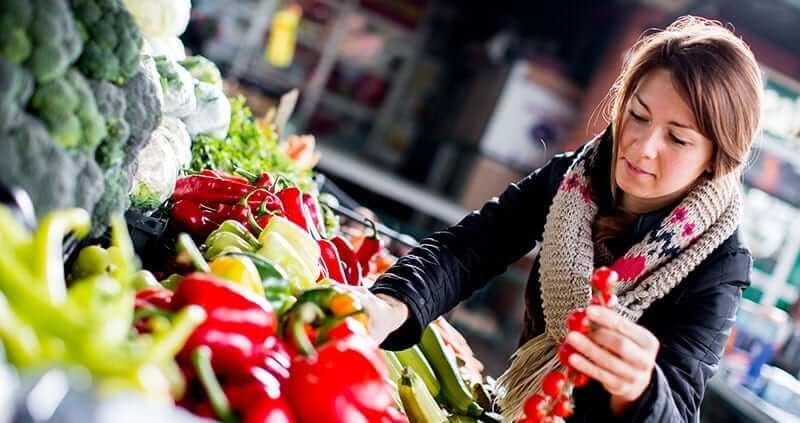Often people with diabetes are concerned about the high cost of eating healthy fresh foods. Fortunately, buying the right foods doesn’t have to break the bank. Learn how easy eating healthy on a budget can be when you have diabetes.
Discover Discounts
There are a variety of ways to score discounts on quality foods. Join the valued customer programs at local grocery stores and mass merchants. Usually, these programs are free to join and can help you save significantly on your favorite foods. Cut coupons from local newspapers, magazines, and value packs sent through the mail. Search online for printable coupons. Use your smart phone to find coupons that can be scanned at the checkout line. Store brands and generic products often cost much less than name brands. Read the labels to make sure the product is comparable to your usual brand. Peruse the weekly sales brochures for local stores to find out which ones are offering the best discounts on diabetes-friendly foods.
Be Prepared to Shop
Before you leave to go shopping, make a grocery list of the food you will be eating healthy during the week ahead. Plan your menus and only buy what you need so food is never wasted. Establish a budget so you know how much you have to spend. Make a list that includes items and basic pricing to keep you on track. Never go shopping when you feel hungry as you may wind up buying more than you need. Learn to resist the temptation of displays offering items that are not on your list. Allow enough time to shop so you don’t feel rushed and make poor decisions. This gives you time to read food labels.
Buy in Bulk
When possible, consider buying nonperishable items in bulk, such as brown rice, no syrup fruit cups, bottled water, whole grain flour, beans, canned tuna, salmon, sardines, chicken, peanut butter, frozen vegetables, dried spices, seasonings and whole grain pasta. Join a shopping club to take advantage of bulk discounts. Lean meats, such as chicken, pork, lamb and beef, can be purchased in bulk and stored in the freezer. It costs less to repackage them into smaller portions than to buy individual packages at the store. Consider cooking in bulk then store and freeze the leftovers. Cooking from scratch is cheaper and healthier than buying frozen, prepared meals. Invest in a few diabetes cookbooks with a focus on eating healthy. Check for diabetes friendly recipes online at reputable websites. Resist the urge to buy items in large quantities if you won’t actually use them before the expiration dates. Consider asking a neighbor if they want to split large packages of fresh produce from shopping clubs.
Smart Ways to Buy Fruit and Vegetables
Fresh fruit and vegetables are always a top choice for people with diabetes, as they contain no additives. Farmer’s markets usually have better pricing on fresh foods. You should buy fruits and vegetables in-season, when they are at the lowest price. Fresh produce can perish quickly so only buy what you will actually consume. Pre-cut vegetables and fruits tend to cost more than produce in its natural form. Purchase whole fruit and make your own fruit salad. Buy heads of lettuce instead of pre- washed packaged lettuce for better pricing. Inquire about discounts on older produce items. If they are not brown or moldy, they are good to eat. Canned vegetables can also be an alternative choice because they take longer to perish and are generally cheaper. Select canned vegetables that are low-salt or no-salt. Choose frozen produce that contains no syrups, sauces or additives.
Spice it up
It is important for people with diabetes to avoid eating packaged, processed and fast foods that contain too much salt, sugar, and fat. Eating healthy foods on a budget doesn’t have to be boring. Spices go a long way when it comes to cost and flavor. Cinnamon adds a sweet taste to tea, yogurt, coffee, and whole grain toast; studies have shown it may reduce insulin resistance. Turmeric adds bold flavor to soups and stews and can act as an anti-inflammatory. Basil makes sauces more delicious and can help lower your blood sugar levels. Garlic brings out the taste of meat and vegetables and has been shown to help reduce blood sugar and lipids as well as act as an anti-inflammatory. Add red wine vinegar, mustard or low carbohydrate BBQ sauce to dishes for immediate taste with little or no sugar.
Pot Dishes
Cooking in one pot or baking dish such as soups, stews, roasts or crock pot cooking can help keep costs down. Bake chicken, frozen vegetables with brown rice or quinoa and dried spices in one pot and you have a complete meal.
Eating Healthy on a Budget with Diabetes
Your own garden is the ideal place to get fresh herbs, vegetables, and fruits. Even if you don’t have a backyard, you can grow a container garden on your balcony or an herb garden in your kitchen. It is easy to grow greens, including basil, rosemary, and spinach. Add some hanging tomato plants to your crop. Make a fresh salad from your own crops and add no-calorie Walden Farms dressing for a tasty treat. Add fresh herbs from your garden to all your favorite recipes. Plus, tending to your garden is great exercise.
Eating Healthy on a budget with diabetes simply requires planning ahead, choosing foods wisely, and cooking your own meals from scratch. Discover the bounty of delicious foods you can eat without going over your budget. It’s worth the effort because eating healthy can improve the overall quality of your life.







Leave A Comment